What Size Rings For Sig 4.5-14-50 On Ar15
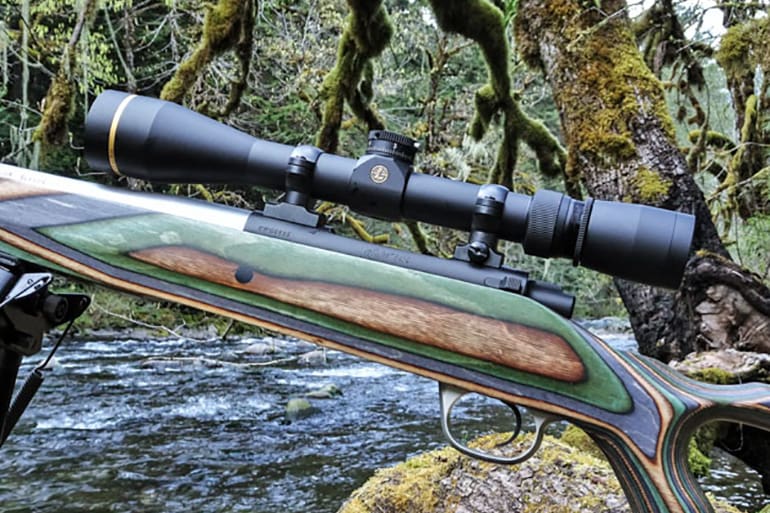
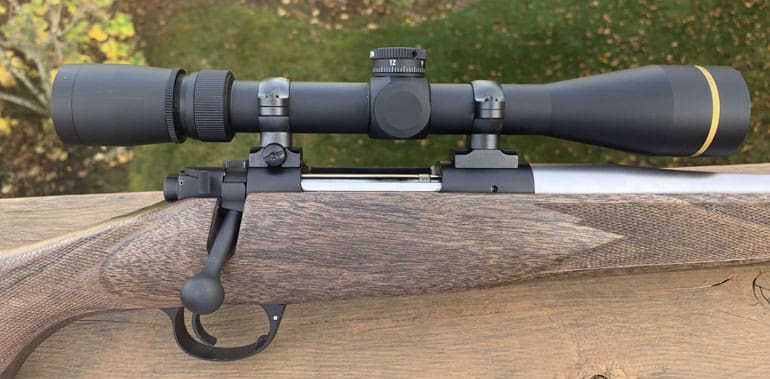
When it comes to hunting scopes, Leupold has always been my go-to scope make. I own over xxx samples of their work. They are rugged and durable, resolve detail in low light, and are very lightweight compared to the contest.
Leupold now adds a significant improvement to their venerable VX-3i blueprint: null lock turrets on their VX-3i 4.5-fourteen×40 CDS rifle scope.
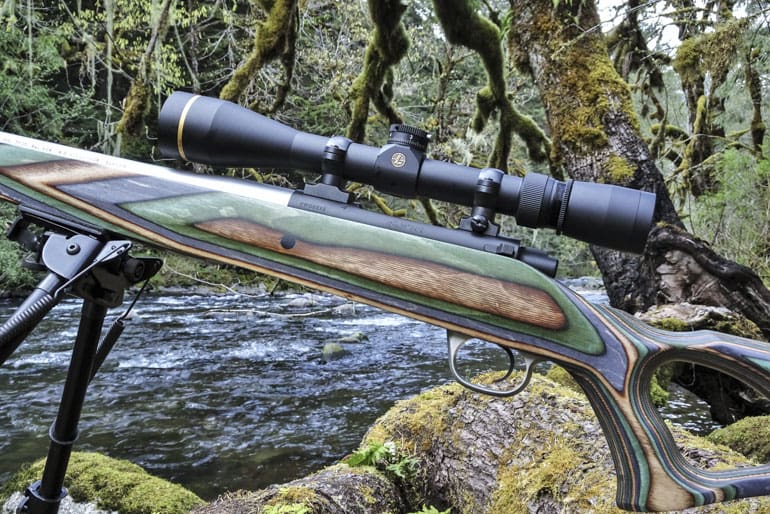
And past "mid-range," I hateful that this scope is, generally speaking, optimized for shots between 100-500 yards. If my typical shot will exist from 50-200 yards (every bit information technology was when hunting in Louisiana), I prefer something similar a 2-7×33 or ane-four×24.
If I'm shooting beyond 500 yards out to, say, 1000 yards (my record is a 735-yard striking on a central Oregon coyote), I really similar a 3-eighteen×44 or a v-25×56. Simply the 4.5-14×40 is a great telescopic for generalist hunting in the mid-ranges, particularly if your eyesight isn't what they used to be.
Some other big reason to get with Leupold scopes is if you're looking for serious weight savings. There aren't many serious, rugged, 14x scopes that counterbalance in at 13 ounces.
The trend in the industry is to move to 30mm tubes, which provide a greater turret adjustment range. But most of the scopes in the mid-ability range are 4-16's, and they typically weigh in it at 21-30 ounces.
For example, the Nightforce iv-14×fifty SHV is an outstanding telescopic, but at thirty ounces, information technology's a chunky monkey. A xxx-ounce telescopic on a 5 lb. ten oz. rifle is a no-get for me.
Leupold'due south traditional VX-3 line featured capped turrets and weren't actually designed for dialing upward your firing solutions. For the near office, that didn't affair to well-nigh hunters, because until recently, the vast bulk of hunters only used turrets to zero their scope. They hunters took the vast majority of their game inside 300 yards in any event.
However, there's a trend in the hunting customs toward longer range hunting, with 500 to 600-yard shots condign more commonplace, and a few hunters even venturing out as far equally 1000 yards and beyond.
Modernistic mid to long altitude hunters either use the scope's turrets to dial in their superlative solution, or use a mod reticle with subtensions for elevation holdovers.
Leupold has finally responded to this trend by updating its turrets in a number of means; Custom Dial System (CDS), zero stop, and, new for 2020, Zero lock.
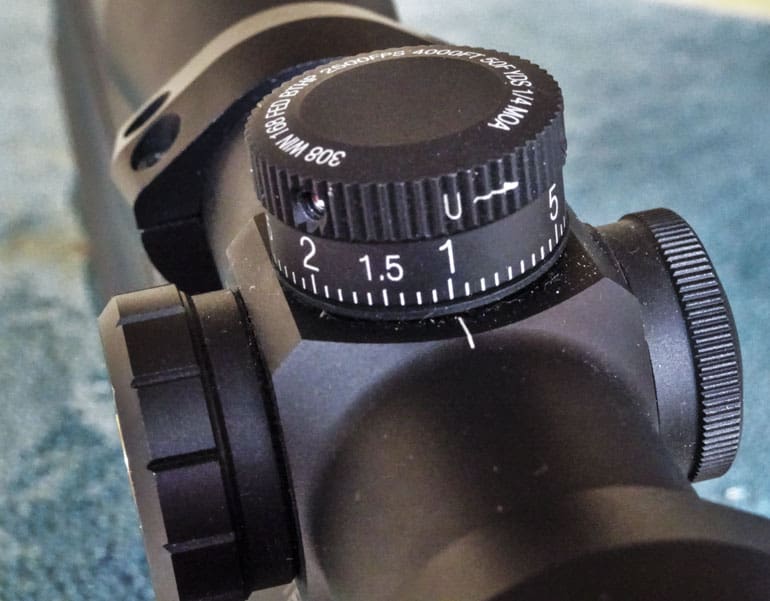
The CDS system is substantially a bullet drop compensation (BDC) device. With a BDC turret design, the turret is marked in distances (say, 100 yards, 200 yards, 300 yards etc.).
The theory behind a BDC turret is that if the hunter knows the range to the target, the hunter need simply plow the dial to that altitude hashmark and take the shot. How well the system works depends on a number of variables, including the selected load, the elevation, and temperature.
If the dial is cutting specific to a special pet load, meridian, and temperature, the results can be quite impressive. Nevertheless, BDC dials frequently give inexperienced shooters a imitation sense of confidence, particularly if the shot is over 300 yards.
For instance, if your turret is cut to lxx degrees at mean sea level (MSL) using Federal 168 grain Gold Medal Match, it isn't going to work at your elk military camp at 7000′ MSL in 35-degree temps using Hornady 178 grain Precision Hunter.
Every bit mentioned above, many of the older Leupold VX-3 turret designs didn't give you whatsoever piece of cake way to remember how many rotations you had dialed on your scope. Zero-stop solved that trouble by allowing the shooter to simply dial clockwise until the turret stopped, which brings the turret back to the rifle's nix.
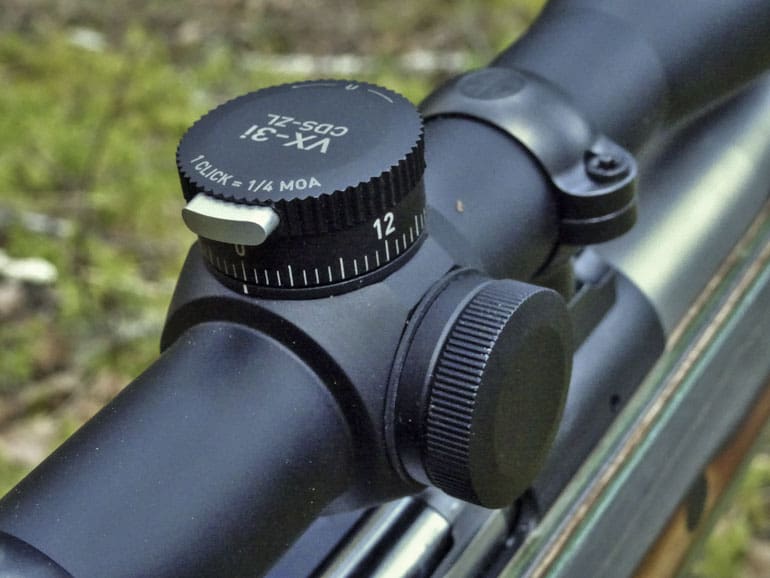
For 2020, Leupold has added a zero-lock feature to the CDS turrets. This feature allows the shooter to lock the turret at the cypher position. This gives the shooter the security of a capped turret, just with the flexibility to dial an tiptop solution if the state of affairs lends itself to that technique.
The windage turret remains a capped blueprint, which is reflective of the fact that few hunters volition dial windage solutions.
Turrets
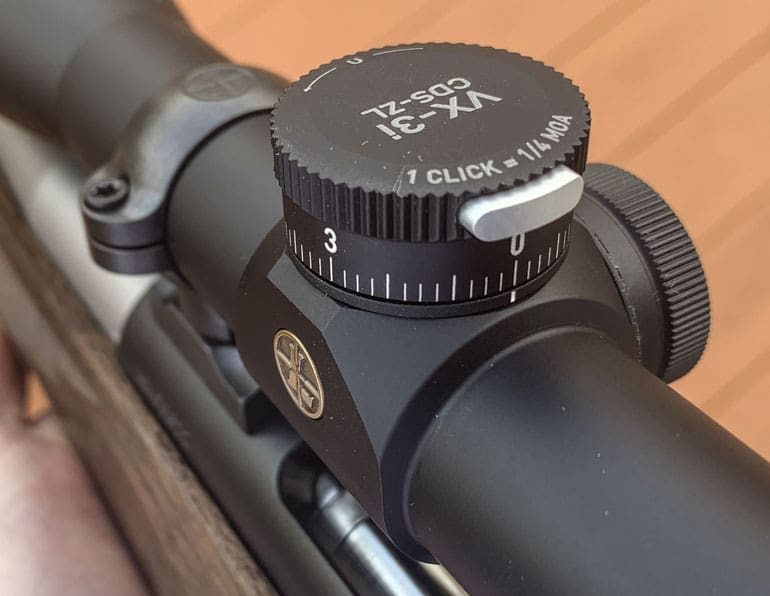
As mentioned above, Leupold's CDS allows you to switch your tiptop turret marker from the MOA standard to a custom BDC turret tuned to your pet load Leupold volition send one costless light amplification by stimulated emission of radiation-marked dial. Again, a BDC turret is marked with altitude hash marks in either yards or meters, which allows the shooter to select the desired altitude instead of counting or memorizing the clicks.
If yous know the altitude to your target is, say 300 yards, you just turn the elevation dial counterclockwise until you reach the "three" mark. The system works if the atmospheric condition equal the data used to cutting the hashmarks on the turrets.

To apply the CDS arrangement successfully, the shooter needs to provide Leupold with fundamental data points:
- Cartridge & Caliber
- Bullet Weight
- Bullet Make/Brand
- Bullet Blazon
- Ballistic Coefficient
- Cage Velocity
- Boilerplate Elevation
- Average Temperature
- Sight Height
- Nothing Distance
It is critical to become this information right, because garbage data will result in bad shooting results. Cage velocity is specially critical.
Once installed, the CDS works well, but is express insomuch as it is calibrated to only one bullet trajectory, and any changes in bullet grain size, temperature, and altitude can affect the results.
For example, I had some of my turrets cut for an altitude of 4000′ MSL, because that'due south the meridian of my practice range. However, if my preferred elk hunting location is at 8000′ MSL, some additional adjustment will exist needed to brand the system work.
In my feel, if the bodily conditions are within xx degrees of the temperature that y'all cutting your turrets for, the custom CDS turret will still exist deadly out to 500-600 yards (+/-). Elevation tin also vary upward to effectually 2,000 feet (+/-) or so before issues arise.
Of course, temperature and elevation differences can either exist cumulative, or they tin abolish each other out, depending on the situation. Information technology takes some thought to factor in the correct adjustment, if any.
If you really want to exist loftier-speed, you tin get multiple turrets cut for different elevations and/or temperatures. For ane of my rifles, I accept turrets cut for 1000, 3000, 5000, and 7000 at fifty degrees F. Changing these turrets doesn't crave re-zeroing, merely I usually re-nothing anyway if I tin.
There's 1 limitation inherent with the Leupold dials that y'all to need to exist aware of: because of the zero end, the CDS system only works with the showtime revolution of the turret. This equates to fifteen MOA of usable height aligning. For my vi.5 Creedmoor, that gets me out to roughly 700 yards at 7000′ MSL. But if the telescopic if being used on a .308 Win, that volition only go you out to 600 yards at the aforementioned tiptop.
Reticle

The reticle on my T&Eastward telescopic is the unproblematic "duplex" reticle. However, Leupold offers other options, including my personal favorite: the Air current-plex reticle. If yous are going to rely on your CDS turret to punch your elevation solution, the Wind-Plex reticle is ideal because it gives you points of reference for wind holds while otherwise remaining uncluttered.
The Air current-Plex reticle subtends forth the horizontal axis in increments of ane infinitesimal of angle (MOA). There are 10 "one-MOA" hash-marks in each direction. Simply you have to remember that on a 2d focal plane scope, the holdovers are calibrated for just i magnification setting. In the example of the American made VX-3i 4.5-14, the hash marks work at the 14X magnification setting. You can also use them at 7X, but in that example each subtension is two MOA.
If the game you're hunting is too skittish to permit you the time to punch your firing solution, a more complex reticle with subtensions will be your huckleberry. Leupold'due south in firm design, which is known every bit the Impact 29 MOA reticle, is a swell selection.
Twilight Max Lens Coatings
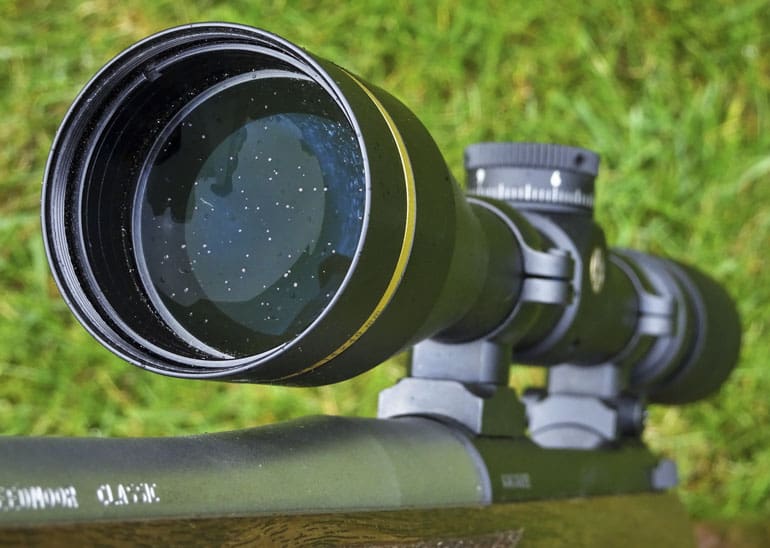
Leupold has three levels or tiers of lens coating systems: Twilight, Twilight Max, and Twilight Max Hard disk drive. Think of these three systems as "good, ameliorate, best."
The Twilight Light Direction Arrangement is the basic serial of lens coating that Leupold applies on its budget-friendly scopes such equally the VX-Freedom line. Information technology combines fantabulous epitome quality, depression glare and multilayer lens coating for a brilliant, loftier contrast image.
The Twilight Max Lite Management System is the mid-tier blanket system and is the one practical to the VX-3i scope line. That makes sense, since the VX-3i is now a mid-tier product line for Leupold. Twilight Max has around 12 to sixteen total layers – roughly twice as many layers as Twilight.
Twilight Max Hard disk is the same coatings as the Twilight Max, but those coatings are applied to HD optical glass, providing even improve resolution, contrast, and color allegiance.
Leupold is pretty tight lipped virtually the specifics related to the Twilight Max system, but speaking in general terms, anti-reflective coatings maximize light transmission while minimizing lens flare, that abrasive haze you lot see in a cheap telescopic. The coatings are engineered to help hunters resolve details in low light.
Leupold says that Twilight Max HD delivers up to 30 extra minutes of shooting light, whereas Twilight Max delivers up to twenty extra minutes of shooting light, and the Twilight delivers up to x extra minutes of shooting light.
While that data may exist useless as an objective mensurate of quality, it does give you a sense of how Leupold rates their three tiers relative to i another.
For me, if scope weight is going to be i of the most important factors in building a hunting burglarize, then the VX-3i line of scopes is the way to get. Sure, the VX-6 line of scopes has better HD glass and a 30mm main tube, merely information technology will add a half pound or more to the rifle's weight while likewise lightening your wallet more.
The VX-3i takes weight off your rifle while leaving some greenbacks in your pocket, and when ounces equal pounds and pounds equal pain, trimming weight from your rifle is the correct answer. But if yous hunting experience involves brusk stalks or ambush techniques (tree or footing blinds, etc.), the weight may not matter as much to you.
Parallax: Adjustable or Not?
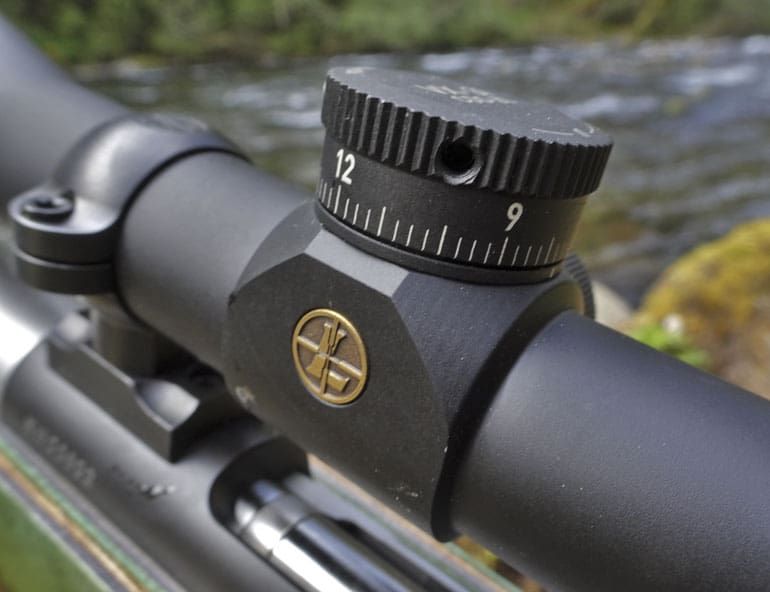
1 big decision you need to brand when choosing a telescopic is whether you need a scope with adjustable parallax. Every bit shown in the photo above, this T&Eastward sample does non have adjustable parallax. Rather, the parallax is set at the factory for 150 yards.
This makes information technology harder to print tiny groups at 50 or 100 yards, and will likewise have some result at longer ranges also. I guess if you can concur your head in the exact same spot every shot, then it doesn't matter that much, but I observe that hard to accomplish in exercise.
Once again, whether you want a side-focus characteristic volition depend on the type of hunting you exercise. If your shots are always within 300 yards and your target is bigger than a golf ball, then y'all don't actually demand it. Likewise, if you're shooting elk-sized targets inside of 400-500 yards, you lot probably don't need information technology either.
Merely if your quarry is small (i.eastward. Belding footing squirrels) or typically found at longer ranges (i.east. prairie dogs), or if y'all like shooting tiny sub-1/2 MOA groups, then you lot need either the "side focus" or an adjustable objective ("AO") design.
For the lightweight Kimber 84M rifle featured in this review, I actually wanted the lightest weight scope possible with 15X magnification, so I opted non to get the side focus. I have to say that I really missed that feature, however.
Tracking
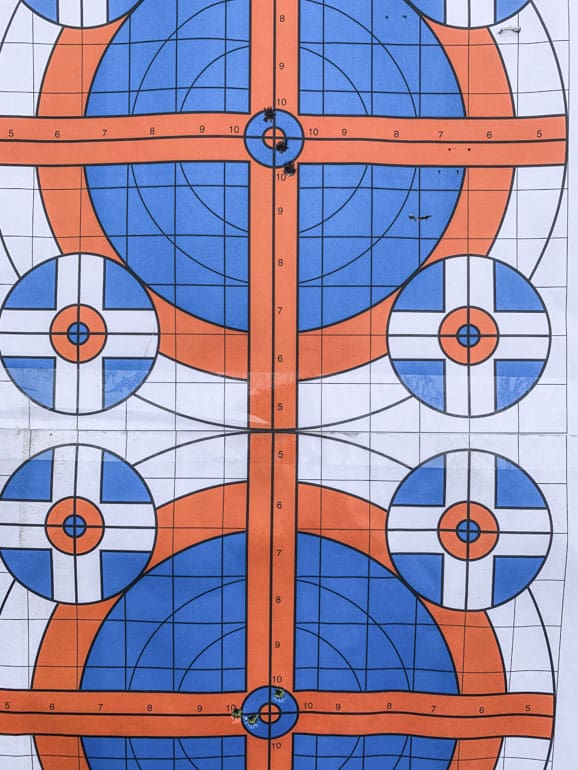
If you are dialing your superlative, your telescopic's ability to accurately and precisely "track" is critical, and it'southward an area where problems frequently occur. The term "tracking" is used to describe a telescopic'south ability to adjust peak and windage correctly, based on being calibrated to a detail angular measurement (either MRADs/Mils or MOA).
Equally an example, if yous dial 10 Mils, a properly tracking scope will raise the bullet strike iii.6 inches at 100 yards and ane yard at 1000 yards. You lot can repeat this test using the windage knob to movement the POI iii inches, 6 inches and 12 inches to the right and left of zero, all while using the same target.
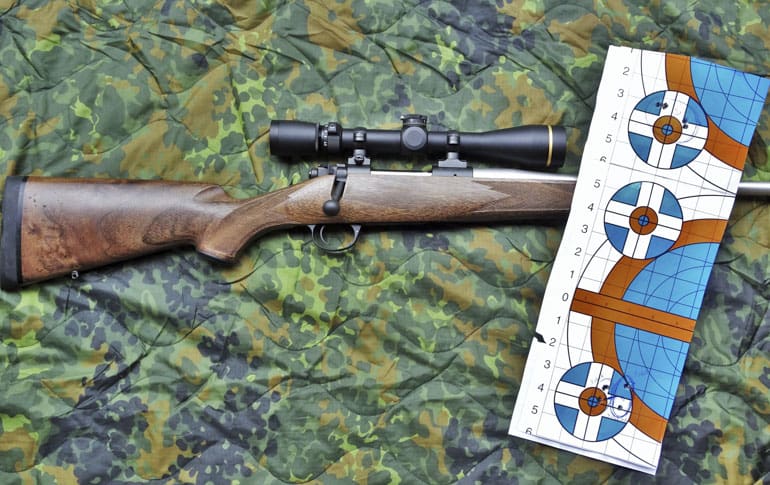
One of my rifles typically needs 11 mils to hit steel at 1000 yards with Federal GMM 175 grain. And so when I dial 11 on the elevation turret, I need to be able to rely on the fact that the scope will actually dial exactly eleven mils, as opposed to 10 mils, 12 mils, or even x.seven mils. If the scope introduces a tracking error, then you won't take the proper elevation or windage and you will non striking your target.
As mentioned above, the Leupold VX-3i's zero end limits the amount of top that I can get out of the turret to around fourteen.v MOA. For my tracking examination, I shot to nada at 100 yards, then dialed 12 MOA and shot once again at my "null" target. If everything is correct, the telescopic volition group 12.56 inches higher than the zero group. As expected, the bullets struck correct above 12.5 inches above the zero target.
One of the sample exam targets is shown to a higher place. One thing you tin can see from the target is that my 12 MOA 5-shot grouping clustered in ii very tight nodes. I shot that test group with my new Boyds Spike army camp stock. The ii nodes tell me that I probably have a force per unit area point on the butt and demand to inlet the stock a bit more to ensure a free-float barrel.
The other affair yous can encounter is that the Leupold scope properly tracked 12.five inches upwardly at 100 yards when I dialed a 12 MOA elevation solution. (1.047 x 12 = 12.56 inches).
Aureate Band Lifetime Warranty
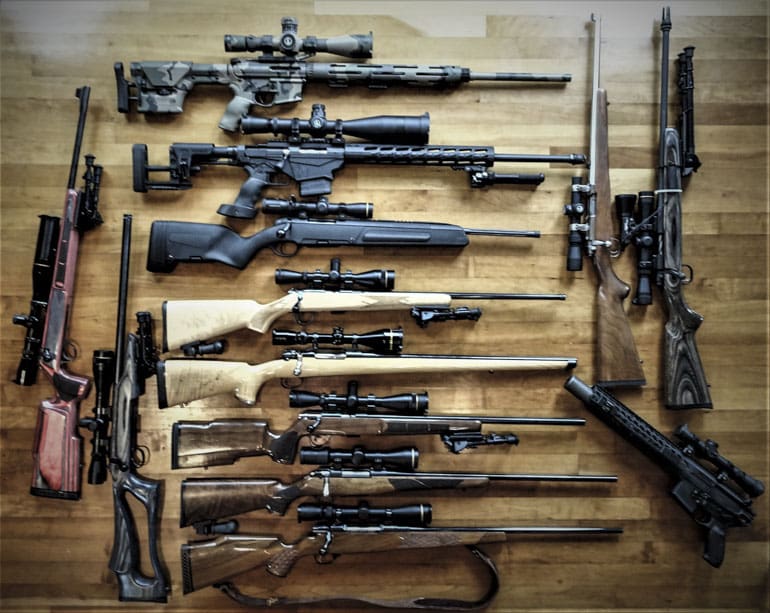
I own over 30 Leupold scopes, from elementary iii×nine VX-2s all the manner upward to the uber-expensive Mark vi 3-18×44 and the Marking 8 iii.5-25×56. A few of those scopes are shown in a higher place.
Needless to say, I take a lot of experience with this brand going back xl years. I accept ever thought that Leupold makes a great scope, merely the new versions are better than the ones made 10 or twenty years ago. The new scopes track better and have better coatings.
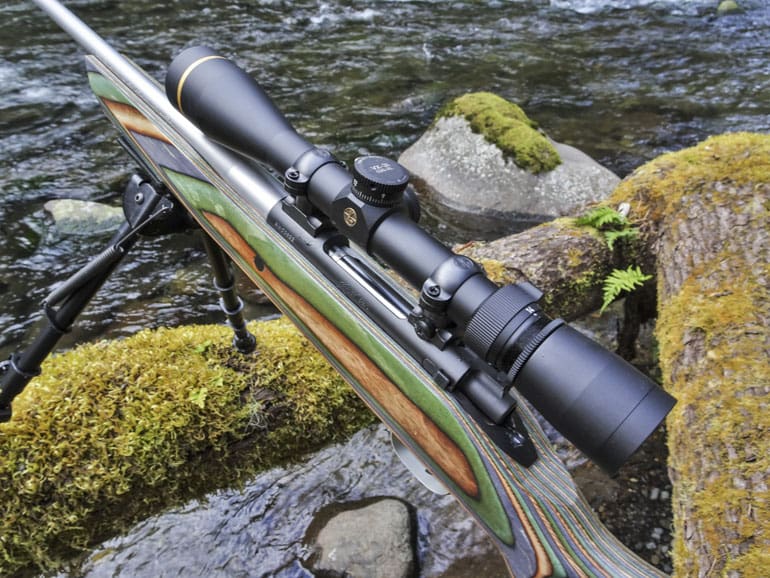
If y'all ever get a tour of the Leupold facility, one definite highlight is the "Punisher." The Punisher is Leupold's recoil simulation car which they use to exam their scope designs.
Earlier moving to production, every epitome has to survive 5,000 impacts on the Punisher, which replicates recoil roughly that of three times that of a .308 Win. round with each impact. Each prototype has to survive 5,000 impacts in order to validate the telescopic design.
Word is that Leupold engineers hate the Punisher, because if the paradigm scope fails to perform in any mode during the tests, the engineers have to go back to the drawing board, make adjustments, and test information technology again.
Maybe that'due south why I've never had a Leupold scope break on me. I did buy a used 1979 Nikko Golden Eagle rifle for $600 in NRA 98% status that was equipped with an older Leupold VX-iii 3.5-10×40 scope. Unfortunately, as soon every bit got home, I realized the objective lens could unscrew, which meant the scope'south gasses had purged.
Leupold's factory is about x miles from my piece of work, then I ran over there 1 mean solar day and they replaced that erstwhile scope with a brand new VX-3i 3.v-ten×40. For Leupold, that was a fair merchandise to gain my continued confidence in their production: I am a customer for life.
These days, there are tons of new telescopic "manufacturers" out in that location. For some reason, guys are always willing to go far line to exist the beta tester for some wing-by-night visitor. Near of those companies don't actually industry anything; they blueprint a telescopic and have produced in Japan, the PI, or China.
I've been shooting for 40+ years, and I've seen these companies come up and get. Thus, when you recall almost a lifetime warranty, y'all take to wonder if your telescopic visitor is going to exist around 10 or twenty years from now when you demand it.
Leupold has been effectually since 1907 and volition undoubtedly be around for a good long time. And they will still accept that same keen warranty they take e'er offered, even though it's highly unlikely that you will ever need to use information technology. That'due south one of the reasons I have 30+ Leupold scopes.
Conclusion

I can remember of only one reason not to buy this telescopic for a mid-range hunting rifle. For most situations, I would spend the extra $65 and purchase the version of the iv.v-fourteen×twoscore that features a side focus (parallax adjustment) turret and Wind-plex reticle (SKU 177820).
At fifteen.8 ounces and the need for heavier 30mm rings, the side focus model will impose a weight penalty, but that is probably worth it on anything other than a mountain rifle.
Specifications: Leupold VX3i 4.5-14×40 CDS Rifle Scope
Length (in) 12.60
Weight (oz) 13.00
Eye Relief (in) – Low iv.40
Eye Relief (in) – High iii.70
Objective Diameter (in) 1.threescore
Reticle: Duplex (Wind-Plex optional)
Linear FOV (ft/100 yd) – Low 19.90
Linear FOV (ft/100 yd) – High 7.40
Acme Adjustment Range (MOA) 64.00
Windage Adjustment Range (MOA) 64.00
Made in America
MSRP: $779.99 (about $600 retail)
Ratings (out of five stars):
Quality: * * * * *
Like all Leupold scopes, the VX-3i four.five-fourteen×forty is very well made right here in the U.s. is and backed by a keen lifetime warranty.
Immovability: * * * * *
I oasis't had the opportunity to accept this particular sample out for a hunting season notwithstanding. However, I've used other Leupold scopes since the late-1970s and never had a problem. Scope prototype quality and low lite performance are getting better and better, so I have replaced most of my older scopes even though they even so technically piece of work.
Drinking glass: * * * * *
The VX-3i'south glass is not the all-time drinking glass Leupold offers, but it is better than anything in its price class. These scopes work very well in depression low-cal. If you want amend (i.east. Hard disk drive) drinking glass, you volition have to pay for information technology.
Reticle: * * *
My T&East sample VX-3i 4.v-xiv×40 came with the bones "duplex" reticle. I would really have preferred the Wind-Plex reticle, so I volition probably have Leupold bandy it out at some betoken.
Overall: * * * * *
The Leupold VX-3i is the standard by which all other mid-priced scopes are judged. The glass is cracking, the scopes are rugged, and best of all, they are incredibly lightweight compared to the competition.
What Size Rings For Sig 4.5-14-50 On Ar15,
Source: https://www.thetruthaboutguns.com/gear-review-leupold-vx-3i-4-5-14x40-cds-rifle-scope/
Posted by: kennedysence1957.blogspot.com


0 Response to "What Size Rings For Sig 4.5-14-50 On Ar15"
Post a Comment